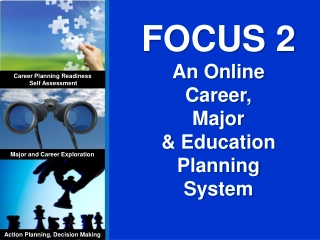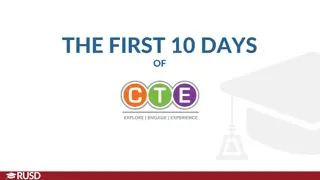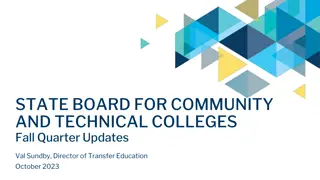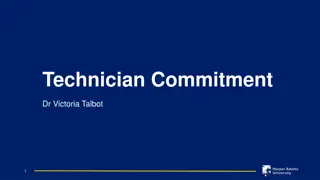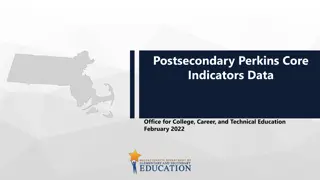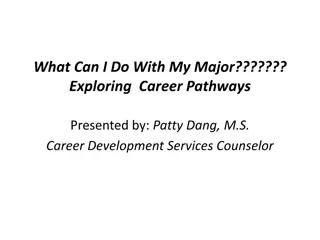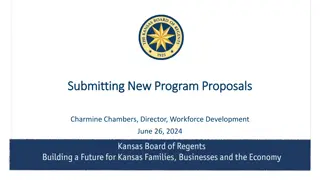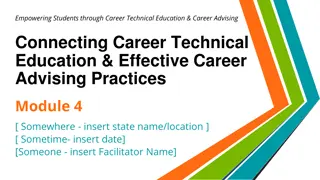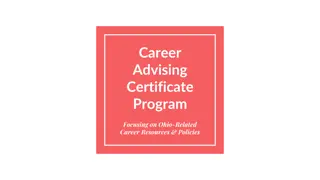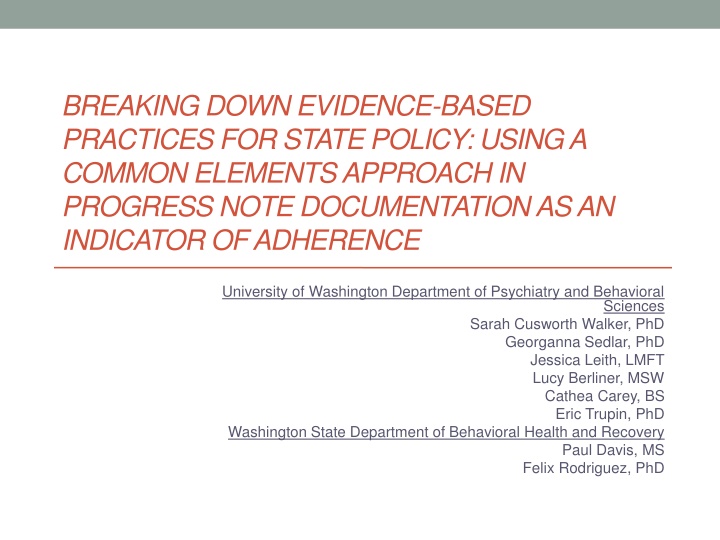
Career and Technical Education MA Program Overview
The Master of Arts in Career and Technical Education program at CSUSB offers specialized education for individuals working in various settings related to CTE. Accredited by CCTC, NCATE, and WASC, this program provides opportunities for advancement in leadership roles. Admission requirements include a Baccalaureate Degree from an accredited institution. To advance to candidacy, completion of specific courses and requirements is necessary, leading to a 45-unit graduation requirement and a master's degree project or comprehensive examination. Explore this program for a rewarding educational journey.
Download Presentation

Please find below an Image/Link to download the presentation.
The content on the website is provided AS IS for your information and personal use only. It may not be sold, licensed, or shared on other websites without obtaining consent from the author. If you encounter any issues during the download, it is possible that the publisher has removed the file from their server.
You are allowed to download the files provided on this website for personal or commercial use, subject to the condition that they are used lawfully. All files are the property of their respective owners.
The content on the website is provided AS IS for your information and personal use only. It may not be sold, licensed, or shared on other websites without obtaining consent from the author.
E N D
Presentation Transcript
BREAKING DOWN EVIDENCE-BASED PRACTICES FOR STATE POLICY: USING A COMMON ELEMENTS APPROACH IN PROGRESS NOTE DOCUMENTATION AS AN INDICATOR OF ADHERENCE University of Washington Department of Psychiatry and Behavioral Sciences Sarah Cusworth Walker, PhD Georganna Sedlar, PhD Jessica Leith, LMFT Lucy Berliner, MSW Cathea Carey, BS Eric Trupin, PhD Washington State Department of Behavioral Health and Recovery Paul Davis, MS Felix Rodriguez, PhD
The Evidence Based Practice Institute is a intermediary organization that supports EBP translation and implementation efforts with the WA State Department of Social and Health Services Division of Behavioral Health and Recovery (DBHR) for children s mental health . . Research Identify gaps in available EBPs based on client need and therapist feedback Policy Translate EBP for real world contexts Support CQI feedback loop Training Broker and develop clinical training to address service gaps
State Fiscal Year 2017 30% benchmark for EBP services in children s mental health (not an inconsiderable challenge with the national average for EBP use in children s public mental health at 1-3%; Bruns, Kerns, Pullmann et al., 2013)
Defining Evidence Based Practice Source Purpose Level of description References the need for rigorous research design Legislative General description Specifies the need for cost- benefit, heterogeneity in race/ethnic sampling, translational capacity and identifies treatment categories based on meta- analysis Washington State Institute for Public Policy/Evidence Based Practice Institute (EBPI) For inventory review Outlines the clinical components in the research- based treatment categories Department of Behavioral Health and Recovery (DBHR)/ EBPI For provider guidance and monitoring
Monitoring the use of multiple EBPs in a cash-strapped system Billing System Provides most real time, arguably least burdensome way to document for providers 2013 Self Determination Allows providers to choose from a number of treatment approaches as long as they are EBP approved 2013 Guidance for Reporting Removes some of the guesswork for providers in whether they are adherent enough to report accurately 2016 instituted after initial estimates because . . .
Without reporting guidance, numbers were suspect EBP benchmarks are based on encounters rather than clients The state error rate for reporting EBPs was 38% with a range across regions of 9 83% Error was defined by 1. Reporting non EBP practices for children s mental health 2. Reporting practices under unrelated encounter types
Designing Reporting Guides Challenge 1: How to establish good intent to deliver an EBP Challenge 2: How to allay provider concerns about whether their individualization/modifications of EBPs were eligible for reporting Challenge 3: How to minimize burden and paperwork by keeping all reporting within existing channels (billing and routine progress reporting)
Challenge 1: Establishing good intent Training Provider must have received LIVE training in the reported treatment Certified trainer or a trainer with documented expertise in treatment approach If reporting a namebrand Provider can document they are adherent with compliance requirements Treatment Plan The treatment plan must list intent to provide at least one ESSENTIAL clinical element of the proposed treatment approach
Challenge 2: Allaying provider concerns about fidelity If the state was allowing only a few interventions, questions about adaptation could be fairly well-managed with expert consultation. However, in a complex system with multiple programs, implementation is considered good enough for counting if the core philosophy and strategy of the treatment is maintained. This reflects and draws from efforts to identify core components to develop flexible treatment strategies adaptable to real world contexts: Diebold et al. (2000) suggest that innovation must reflect what they call "assimmodation," a balance of assimilation of innovations to existing structures and accommodation of those structures to incorporate key elements. (Elias et al., 2003) Elias, M. J., Zins, J. E., Graczyk, P. A., & Weissberg, R. P. (2003). Implementation, Sustainability, and Scaling up of Social- Emotional and Academic Innovations in Public Schools. School Psychology Review, 32(3), 303-319. Kendziora, K., & Osher, D. (2016). Promoting Childrens and Adolescents Social and Emotional Development: District Adaptations of a Theory of Action. Journal of Clinical Child and Adolescent Psychology, 45(6), 797-811. doi:10.1080/15374416.2016.1197834
Identifying Components Began with treatment categories as identified by WSIPP in meta- analyses indicated as research-based on the state inventory e.g., CBT for Anxious Children Reviewed available taxonomies, meta-analytic studies and dismantling studies of clinical components for these categories (e.g. below) Chorpita, B., Daleiden, E., & Weisz, J. (2005). Identifying and selecting the common elements of evidence based interventions: A distillation and matching model. Mental Health Services Research, 7(1), 5-10. Weisz, J. R., Chorpita, B. F., Palinkas, L. A., Schoenwald, S. K., Miranda, J., Bearman, S. K., . . . Gibbons, R. D. (2012). Testing standard and modular designs for psychotherapy treating depression, anxiety, and conduct problems in youth: A randomized effectiveness trial. Archives of General Psychiatry, 69(3), 274-282. doi:10.1001/archgenpsychiatry.2011.147 Wright, C., Catty, J., Watt, H., & Burns, T. (2004). A systematic review of home treatment services. The International Journal for Research in Social and Genetic Epidemiology and Mental Health Services, 39(10), 789-796. doi:10.1007/s00127-004-0818-5 Consulted with clinical experts to validate and refine the components Essential are 1) designated components that are in at least 80% of effective treatment programs for that category, 2) are reasonably distinct from other treatment category practices, 3) appear to be independently effective. Allowable are clinical components common to effective treatment categories that may or may not cross multiple treatments (e.g., problem solving).
Challenge 3: Minimize reporting burden and paperwork Checklist for Determining Whether a Service Encounter is an R/EBP 1. Training: The provider received training in the R/EBP certified training OR a training that covered essential elements of practice. 2. Consultation: The provider completed the consultation requirements of a name brand program (only applicable for name brand R/EBP). 3. Treatment Plan: The provider lists at least one essential clinical element in the treatment plan for the indicated client. 4. Progress Notes: The provider lists at least one essential or approved clinical element in the progress notes for the indicated client session.
Self-Reporting Guide for SERI Evidence-Based Modifier Codes Cognitive Behavioral Therapy for Anxious Children (individual, remote, group) The following checklist is a guide for when you can report the use of a research/evidence-based practice (R/EBP) in SERI. You need to meet the guidelines in all three categories in order to report an R/EBP for any specific session. The three categories include 1. Eligible training 2. Listing at least one essential clinical element in the treatment plan 3. Listing at least one allowable clinical element in a progress note for that session. I. Approved training organizations for the category: To report an R/EBP modifier code, you must be able to document that you received a certificate for attending an approved training for the R/EBP you are reporting. Below are approved training programs and entities for this treatment category. If you do not see your training listed, you must be able to document (i.e., training outline) that the training you received covered all of the essential elements in Section II. Training must be in person with a training certificate provided. If you are not sure whether your training counts please contact the Evidence-Based Practice Institute. Effective Child Therapy/Society of Clinical Child & Adolescent Psychology Harborview Center for Sexual Assault and Trauma (CBT+) The Reach Institute (CATIE trainings) Centre for Emotional Health (Cool Kids) CBT 4 CBT training (Coping Cat) Check one Modularized Approach to Therapy for Children with Anxiety, Depression, Trauma, or Conduct Problems (MATCH-ADTC) Mapping and Adapting Practice (MAP) Cool Kids Coping Cat Coping Cat/Koala book based model Coping Koala Other Live Training: Provider can document that the training agenda covered all Essential Elements for this program type (below). Ia. Receiving active consultation in a specific treatment type If you are reporting a name brand R/EBP you must be in compliance with the required training, certification or consultation requirements of the program. II. Treatment Plan - Are all the following essential clinical elements listed in the treatment plan? The Evidence-Based Practice Institute has identified the most essential elements of treatment based on the frequency and effectiveness of therapeutic techniques in this category. These essential elements must be clearly indicated in a treatment plan for a presenting diagnosis in order to report an R/EBP modifier code. The essential elements do not need to be implemented in the service being reported as long as they are in the treatment plan and progress notes reference the treatment plan. a. Exposure Description: Exposure is a practice to decrease anxiety associated with an object or situation. The practitioner should 1) gather information on the situations or objects that make a child anxious. 2) Have the child practice being exposed to feared objects or situations in gradually increasing amounts. 3) Repeat exposure exercises until fear is reduced or tolerated. b. Cognitive Restructuring Description: Cognitive restructuring Involves teaching children how thoughts can influence anxiety and helping them come up with more true and helpful thoughts III. Session Progress Notes - Is at least one of the following clinical elements listed in the progress note for the session? At least one of the therapeutic techniques listed below must be documented in progress notes in order to report an R/EBP code for the reported service. a. Exposure Description: Exposure is a practice to decrease anxiety associated with an object or situation. The practitioner should 1) gather information on the situations or objects that make a child anxious. 2) Have the child practice being exposed to feared objects or situations in gradually increasing amounts. 3) Repeat exposure exercises until fear is reduced. b. Cognitive Restructuring Description: Cognitive restructuring Involves teaching children how thoughts can influence anxiety and helping them come up with more true and helpful thoughts c. Tangible Rewards (aka incentives, reinforcers) Description: Caregivers are taught to provide rewards when a child confronts a situation or object that causes fear. d. Modeling Description: Modeling is used to promote rapid acquisition of new skills. It provides an opportunity for a caregiver to demonstrate the skill or to cue the child to use the skills in appropriate situations. e. Psychoeducation for caregivers
Feasibility Evaluation 2017-2018 Evaluation Plan Adherence: EBPI will roll out up to 12 regional trainings on using the Reporting Guides. Participating sites (anticipating 12-15) will be asked to provide 10-20 randomly drawn cases subsequent to the training which will be scored for adherence with the RG standard. Acceptability Following in person trainings, EBPI will send a survey to participants containing the EBP Attitudes Scale and questions about the acceptability of the Reporting Guides in practice. Knowledge: An instructional web video (link below) will be disseminated through the children s mental health network with all subcontracted agencies encouraged to have providers view and take a short knowledge-based quiz. Anticipating 100-300 responses for assessing knowledge of how to document practice. All participants in the live training will take the same quiz (anticipated 50-100), allowing for an assessment of training context on knowledge.
Thank you! For inquiries: Sarah Cusworth Walker secwalkr@uw.edu Acknowledgments: Division of Behavioral Health and Recovery Behavioral Health Organization child care coordinators The Washington State Institute of Public Policy (WSIPP/ Marna Miller) Ron Gengler and staff (Comprehensive) Melissa Gorsuch-Clark and staff (Catholic Family and Child Services) Suzanne Kerns Eric Bruns Greg Endler

